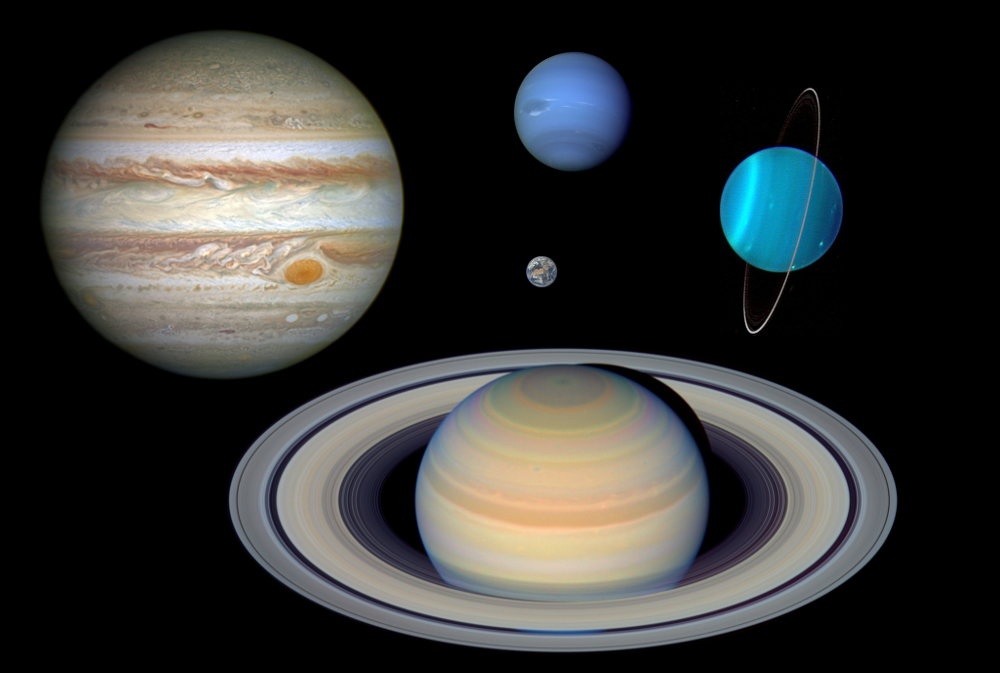
Source for the images can be found at http://spiff.rit.edu/classes/resceu/ss_planets/earth_moon_lineup.html
 Copyright © Michael Richmond.
This work is licensed under a Creative Commons License.
Copyright © Michael Richmond.
This work is licensed under a Creative Commons License.
You already know that Jupiter is big. We covered that last time.

Source for the images can be found at
http://spiff.rit.edu/classes/resceu/ss_planets/earth_moon_lineup.html
But that picture doesn't give an accurate representation for how MASSIVE Jupiter is, compared not only to the Earth, but to everthing else. Do the math:
mass of large bodies, in kg
Mercury 0.33 x 1024 Jupiter 1898 x 1024
Venus 4.87 x 1024
Earth 5.97 x 1024
Mars 0.64 x 1024
Saturn 568 x 1024
Uranus 86.8 x 1024
Neptune 102 x 1024
Pluto 0.01 x 1024
----------------------------
total
Some scientists have described the Solar System as "the Sun, Jupiter, and bits of rubble," or words to that effect. To some extent, it's true: Jupiter is so much more massive than the other planets that it dominates much of the dynamics.
For example, the orbits of asteroids show big gaps at locations which would yield regular perturbations by Jupiter ... but not at locations which are related to the orbital periods of Saturn or Uranus or Mars.
Another example: as we will see later in the course, one of the ways that astronomers search for planets around other stars is to look for changes in the radial velocities of the host stars due the gravitational pull of their planets.
(Click the image below to start a demonstration of the effect)
Jupiter's large mass mean that its gravitational force pulls the Sun around its common center of mass strongly. In fact, the Sun makes a small orbit around this center of mass with a speed of about 12 meters per second, around 27 miles per hour. That doesn't sound like much ...
Q: How fast does the Earth move in its orbit
around the Sun?
(Hint: it travels a circle of radius 1 AU (= 150 million km) in 1 year)
(Hint: there are about π x 107 seconds in a year)
Indeed, the Sun's motion due to Jupiter's pull is pretty slow; but astronomers have created instruments which can measure such small speeds. If there were a Jupiter-like planet orbiting around a Sun-like star, then we could detect it pretty easily!
That's not true of most other planets. The Earth, for example, does exert a gravitational force of its own on the Sun; but the motion of the Sun due to the Earth's influence is less than 1 meter per second, which is smaller than our current instruments could detect reliably.
There are several other ways to detect planets around other stars. One of the most common is the transit method, in which one stares at a star for a long time, measuring its brightness over and over and over, looking for a brief little dip which might indicate that a planet has passed in front of it.
Now, this method works best when the planet is large -- it will block a lot of light, and the dip in brightness will be easy to detect. So, which will create a more obvious transit: Jupiter, or the Earth?
Right -- Jupiter will block more light. In fact, Jupiter will block about 1 percent of the Sun's light, creating a dip which is pretty easy to detect with ordinary telescopes. But the Earth blocks only about 0.008 percent of the Sun's light; only special telescopes in orbit can possibly detect such a tiny change in brightness.
Planets with the same sort of giant size and tremendous mass as Jupiter are the easiest for astronomers to detect around other stars. As you will see in a few weeks, our catalogs of extrasolar planets are full of alien "Jupiters".
The Earth rotates on its axis once every 23 hours, 56 minutes and 4 seconds (= 23.9345 hours), as you all know.
What? You though it was once every 24 hours? That's only if you wait until the Sun returns to its previous location in the sky. We astronomers are accustomed to watching stars, and waiting for a star to make one complete circuit of the sky. The difference -- about 4 minutes -- is due to the Earth's orbital motion around the Sun, which shifts the Sun backwards a bit in the sky.
But Jupiter rotates much more quickly. The sidereal (which means "relative to the stars") rotation rate of Jupiter is only about 9 hours, 55 minutes and 30 seconds (9.925 hours). Astrophotographer Damian Peach was able to record one full rotation of the planet during a single night in 2016. Click on the image below to see his video.
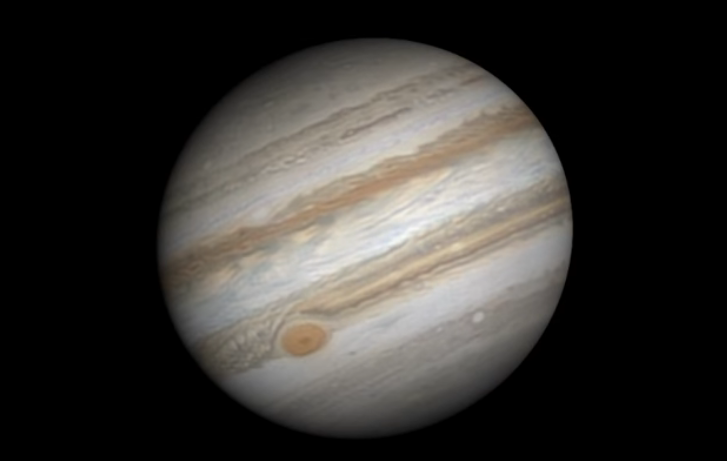
Image and movie of Jupiter
copyright
Damian Peach
planet radius rotation period equatorial speed
(km) (hours) (km/sec)
----------------------------------------------------------------------
Earth 6,378 23.9345
Jupiter 71,942 9.9250
----------------------------------------------------------------------
The centrifugal force due to this rapid rotation pulls the atmosphere near the equator outward to form a very prominent bulge. If you look carefully, you can see that Jupiter looks flattened, pole-to-pole.
The rapid rotation helps to drive the high wind speeds in Jupiter's atmosphere. Relative to the overall rotation of the planet, gas in the belts and zones move at speeds of several hundred km per hour.
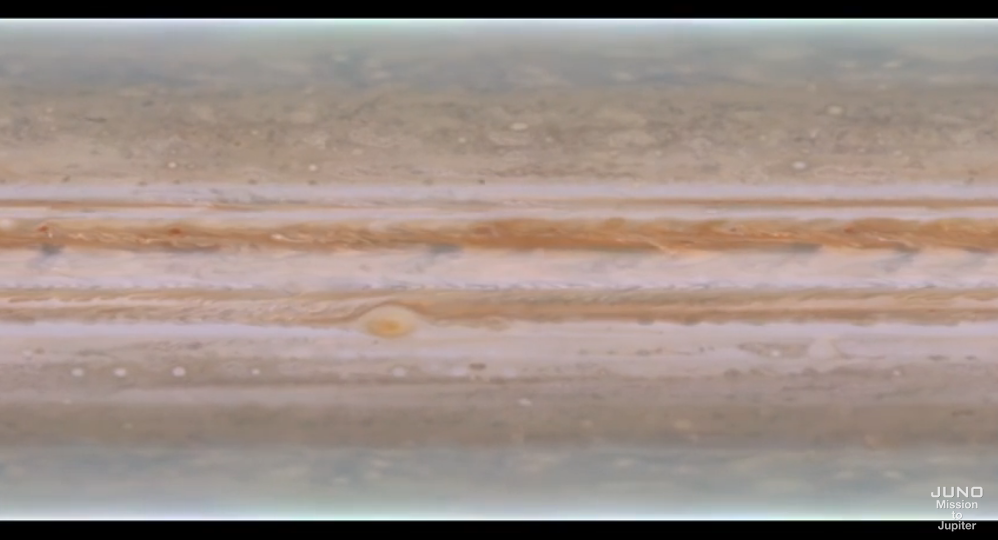
Movie of Jupiter taken by Cassini spacecraft,
courtesy of
NASA and Project Juno
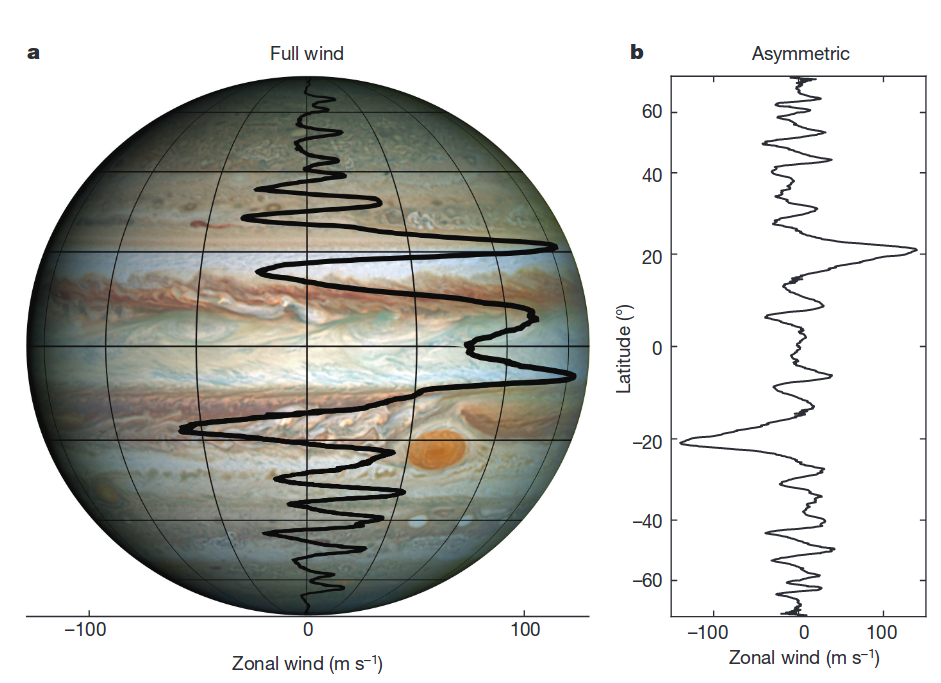
Figure 1 taken from
Kaspi et al., Nature 555, 223 (08 March 2018)
The pictures of Jupiter's atmosphere show it divided roughly equally into light zones and dark belts. The colors are, obviously, different: light vs. dark. Another difference is their east-west motion: the gas in the zones moves faster than the average rotation, and the gas in the belts moves somewhat slower.
But there's a more subtle difference, too: temperature. The gas in the light zones is cooler, and the gas in the dark belts is warmer. You can see this clearly in an image taken with an infrared camera. Bright areas in the IR are hot, and dark areas in the IR are cool.
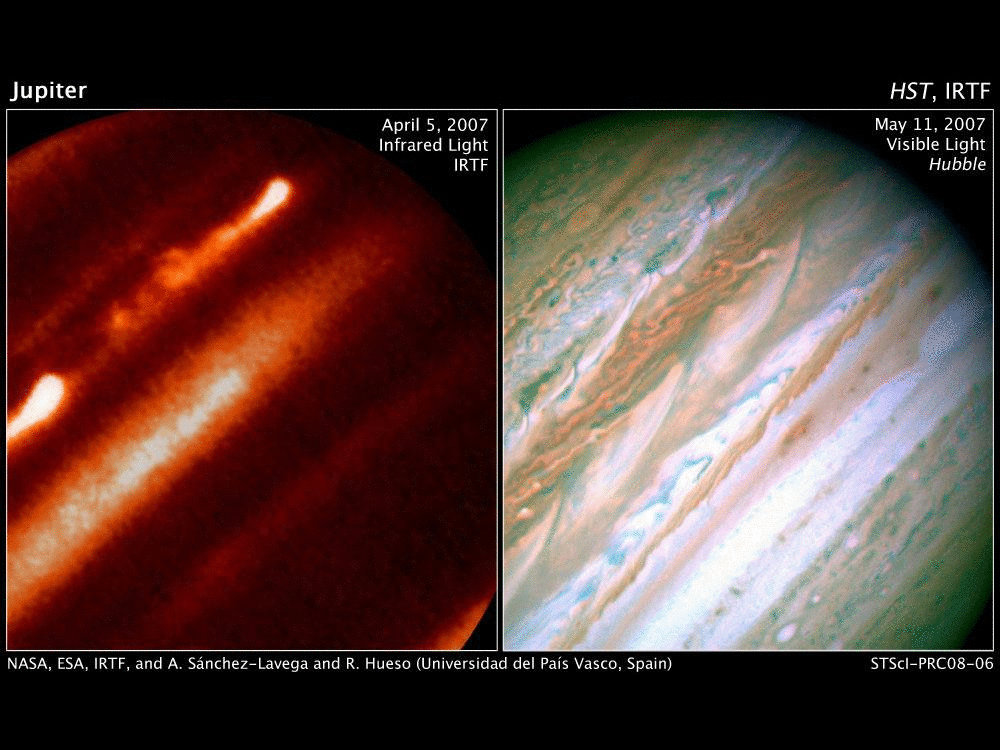
Images courtesy of
NASA, ESA, IRTF, and A. Sánchez-Lavega and R. Hueso (Universidad del País Vasco, Spain)
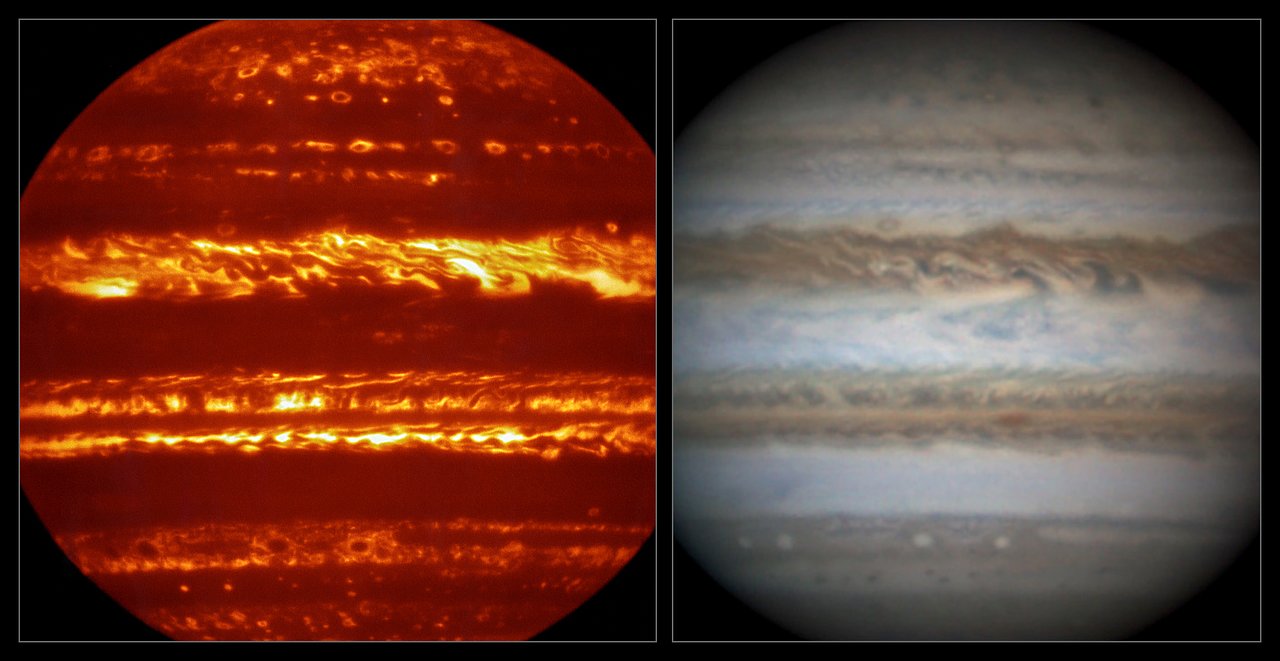
Image courtesy of
ESO/L.N. Fletcher/Damian Peach
What's going on?
Heat from the interior of Jupiter warms its atmosphere -- it's much warmer deep inside than out near the boundary with space. In some regions, warm gas rises upward; as it rises, it gradually cools off, so that when it finally reaches the top of the atmosphere, it is slightly cooler than the surroundings. In this cool gas, icy crystals of ammonia can form, creating a haze that makes the zome appear light in color.
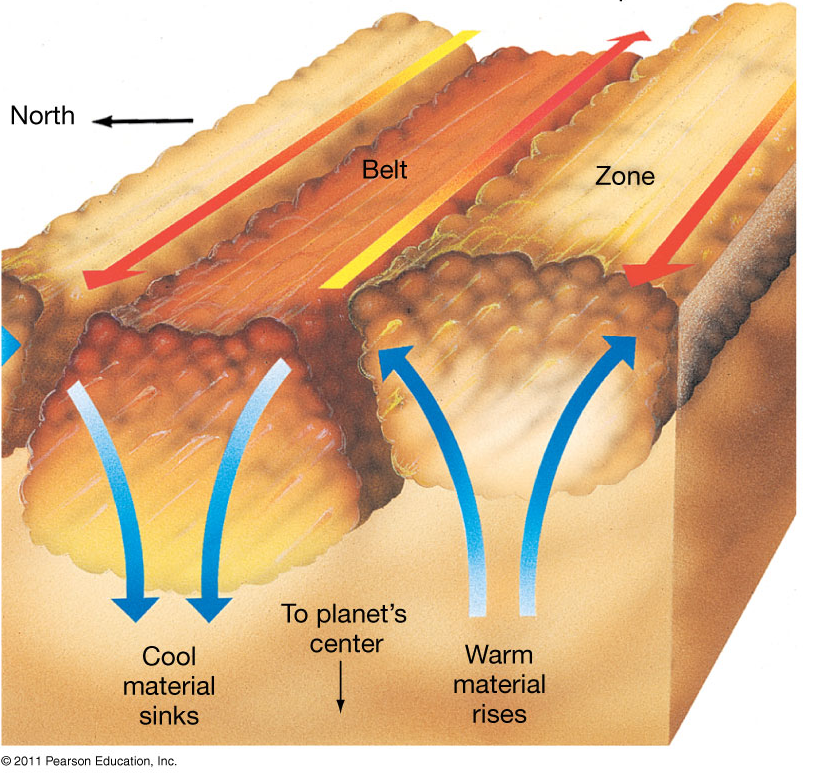
Image copyright (2011) Pearson Education Inc.
But in neighboring regions, gas is sinking down into the interior. As it sinks, it heats up, destroying ammonia crystals and forming other molecules which give the clouds a darker appearance.
This process, in which warm cells of gas rise up and cooler cells sink down, is called convection. It happens in Earth's atmosphere, too. But the process is more significant on Jupiter because of the greater contribution of energy from Jupiter's interior.
Let's compare the flux of energy that these two planets receive from the Sun and produce from their deep interiors:
planet energy from Sun energy from interior ------------------------------------------------------------------- Earth 1370 W per sq.m. 0.002 W per sq.m. Jupiter 50 W per sq.m. 20 W per sq.m. -------------------------------------------------------------------
The Earth receives tens of thousands of times more energy from the Sun than it emits itself; thus, our weather and atmospheric patterns are driven almost entirely by sunlight. But on Jupiter, almost half of the energy reaching its atmosphere comes from below, rather than above.
What is the source of all this internal energy?
GRAVITY
Let me explain. You know that if you hold a ball several feet above the floor, and then release it, the ball will fall down. As it falls, the ball speeds up. Gravitational Potential Energy (GPE) turns into Kinetic Energy (KE). Just before the ball hits the floor, all of the initial GPE has turned into KE. And when the ball collides with the floor, the energy is converted to sound, elastic deformation of the ball and the ground, and into heat.
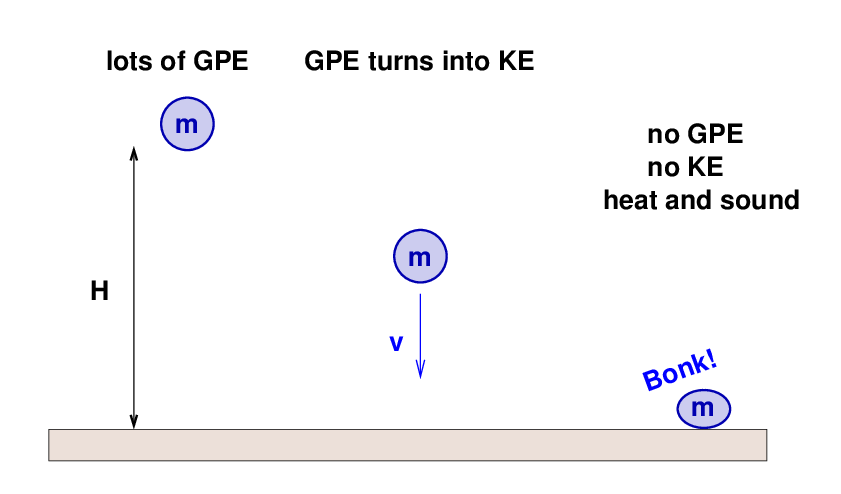
The same conversion of GPE to heat can happen if a big spherical object shrinks down to a smaller spherical object.

Just how much would Jupiter have to shrink in order to produce all the energy which we can measure flowing out of its interior?

where
G = 6.67 x 10-11 N*m2/kg2
M = 1898 x 1024 kg
R1 = 71,500,000 m (initial radius)
R2 = ? (final radius)
Jupiter's contraction produces a LOT of energy: over the course of each year, Jupiter radiates away roughly 1025 Joules. So, can you figure out how far Jupiter must shrink each year in order to produce so much heat?
Q: How much does Jupiter shrink each year?
a) about 10 meters
b) about 1 meter
c) about 0.1 meter
d) about 0.01 meter
e) about 0.001 meter
Should we expect to see this change in size? No, not really.
You may be wondering if there are other sources of heat deep inside Jupiter. Is it possible that fusion reactions might be taking place in its core, just as they do inside the Sun's core?
Alas, no. Jupiter is not massive enough to create the very high temperatures required to start a self-generating hydrogen fusion reaction. That requires temperatures of around 10 million Kelvin, which is far above that inside Jupiter. Models of stellar interiors suggest that the minimum mass of an object which can sustain fusion is around 80 times that of Jupiter. So Jupiter doesn't even come close (despite what the monoliths might say).
It may not be a star, but Jupiter is still an impressive -- and dangerous -- object. Swirling around it, and extending away for millions of kilometers, is a very strong magnetic field.
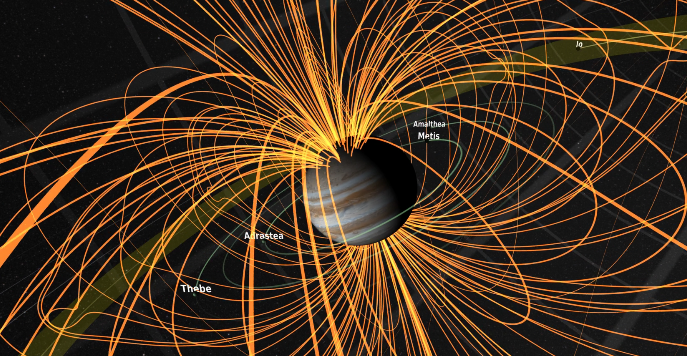
Image and movie courtesy of
NASA's Scientific Visualization Studio and JPL NAIF
Like the Earth's magnetic field, it has a north pole near one end of its rotational axis, and a south pole near the other. Notice how the magnetic field lines intersect with the atmosphere in a ring-like region around each of the poles.
But Jupiter's magnetic field is much stronger than Earth's. Earth's field has a strength of about 0.5 Gauss at its surface, but Jupiter's is about 4 Gauss near the cloudtops.
Why are magnetic fields dangerous? The problem isn't with the fields themselves -- they aren't strong enough to damage the atoms and molecules in our bodies. The problem is with the "guests" that like to visit the magnetic field: charged particles. Charged particles will spiral around and around a magnetic field, following it wherever it goes.
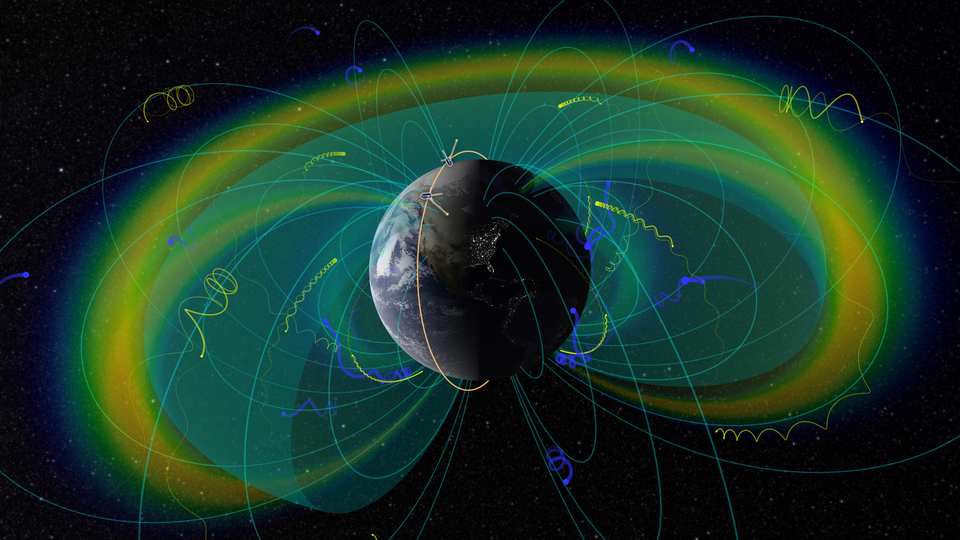
Image courtesy of
UCLA EPSS/NASA SVS
If those charged particles happen to follow magnetic field lines into the atmosphere of the Earth, they smash into atmospheric atoms, exciting them so that the atoms glow with an eerie light. We call these beautiful displays of glowing air aurorae (singular: aurora).
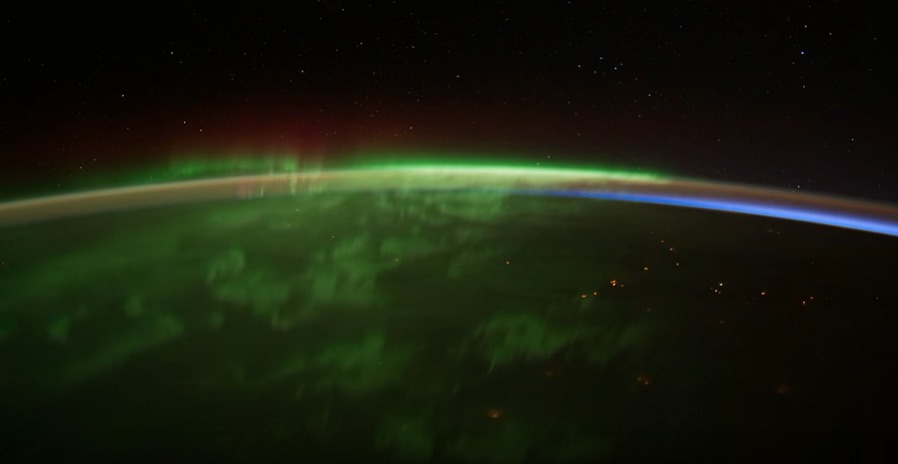
Image and video of aurora from ISS courtesy of
Image Science & Analysis Laboratory, NASA Johnson Space Center
You can also see a similar video
on Youtube.
Since Jupiter has a strong magnetic field, we might expect to see aurorae near its poles. And, in fact, we do; in this still image from HST ...
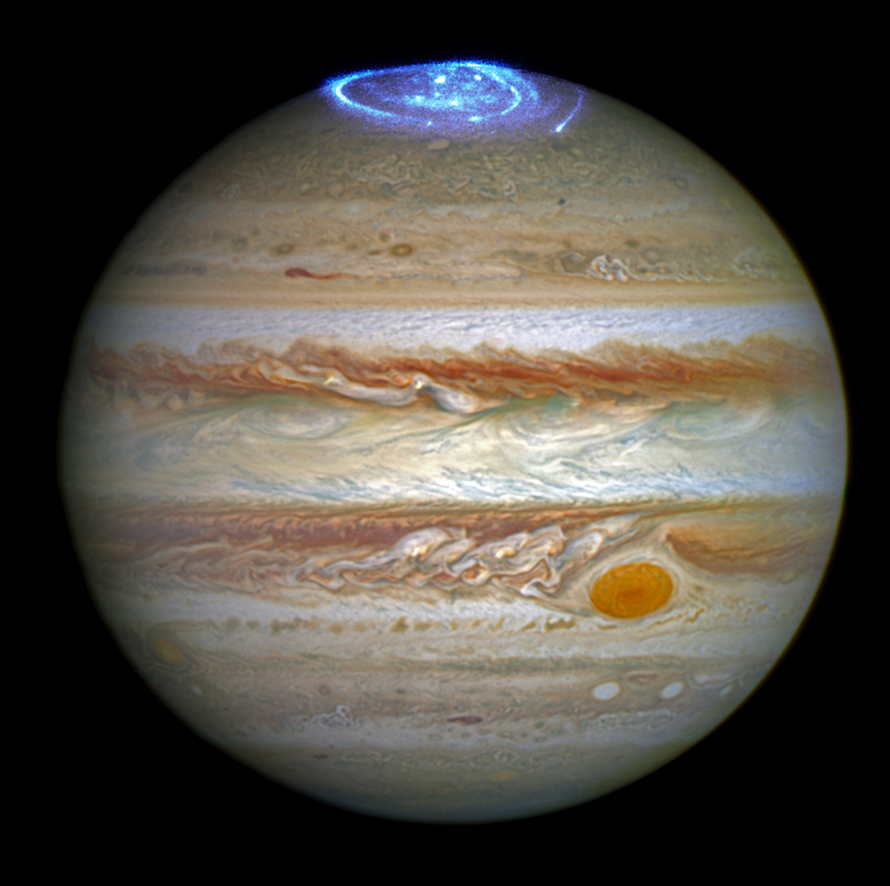
HST image courtesy of
NASA, ESA, and J. Nichols (University of Leicester)
... and from the Juno spacecraft currently in orbit around Jupiter.
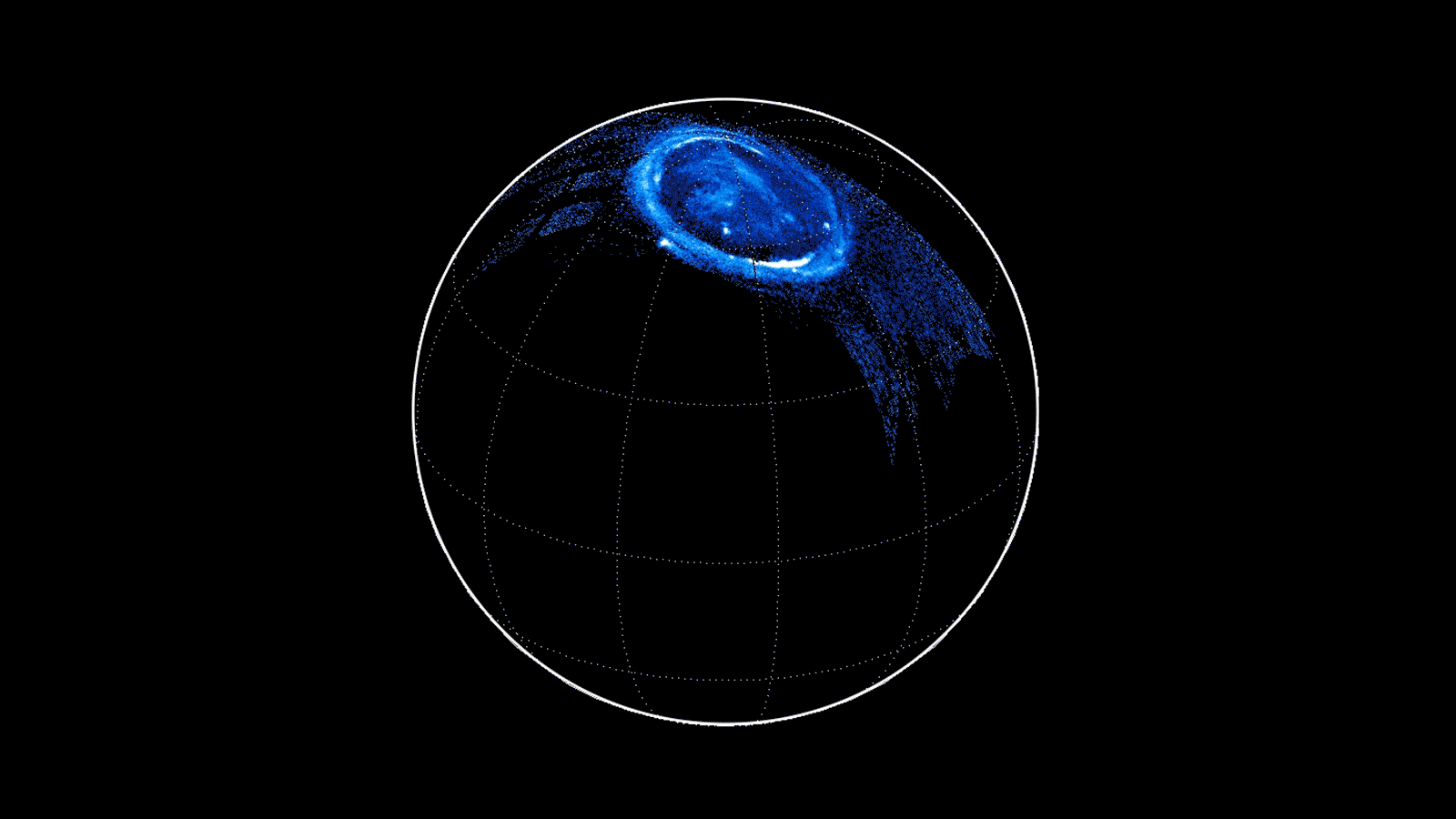
So where's the danger? The danger lies in the charged particles which can become trapped within a strong magnetic field. Although some of the particles may follow the field lines into the atmosphere and transfer their energy to atoms of gas, many particles just cycle back and forth, from northern pole to southern pole, remaining in space. The number of particles grows and grows, creating a region of space full of energetic electrons and protons.
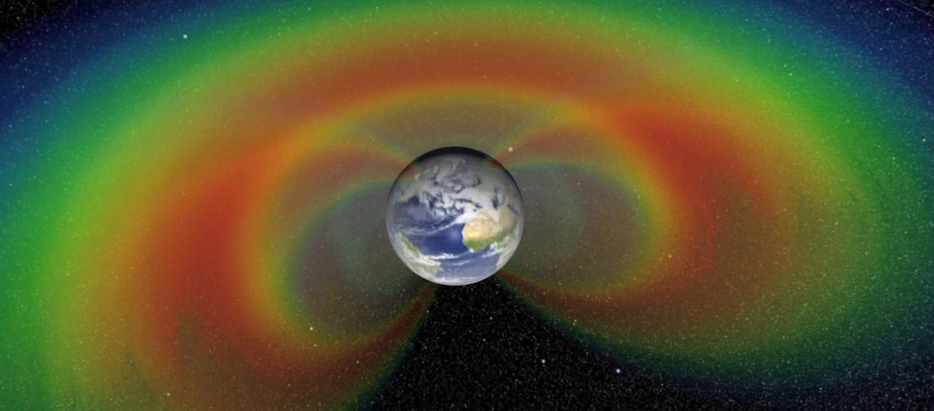
Image and movie courtesy of
NASA/Goddard Space Flight Center Scientific Visualization Studio
We call these regions around the Earth the van Allen radiation belts. The strongest concentrations of particles are found in two regions: an inner belt, and an outer belt.
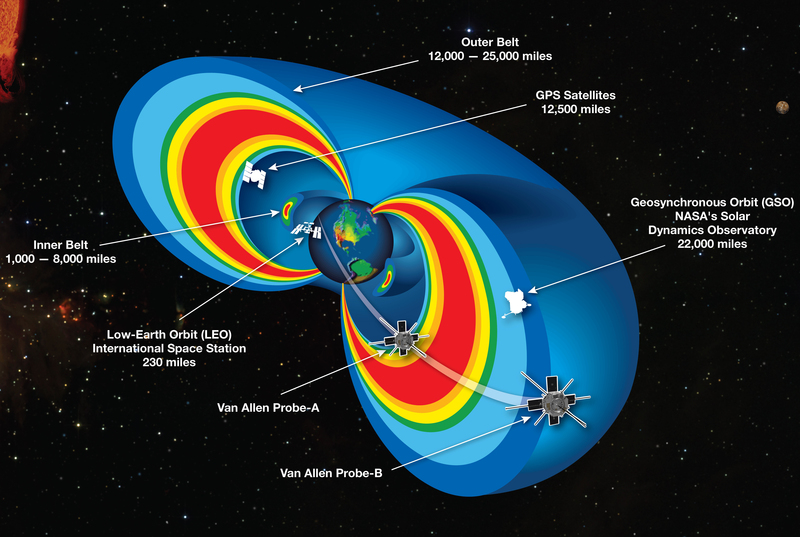
Image courtesy of
NASA
Fortunately for astronauts and satellites, the regions between these belts are nearly free of charged particles.
Jupiter's magnetic field also collects charged particles, which means that the space around Jupiter can be hazardous to spacecraft and humans. The strongest concentrations are very close to the planet's cloudtops ...
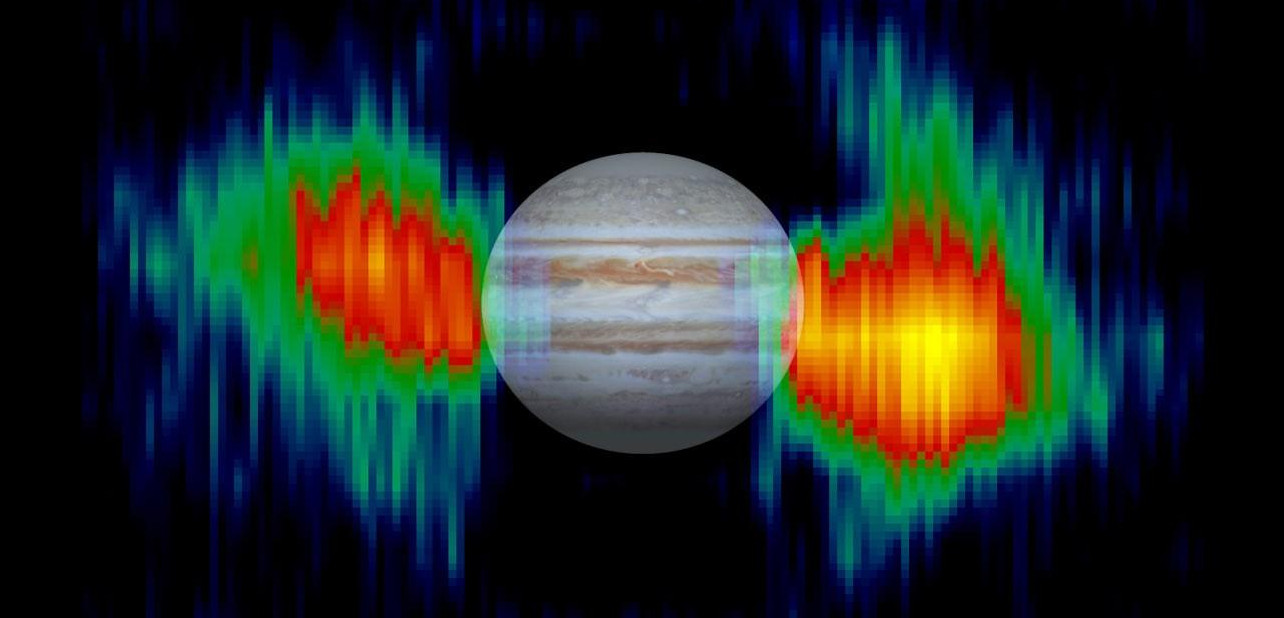
Image modified slightly from the made by
NASA/JPL/Space Science Institute
... but there are still high levels of energetic electrons at the distances of the big Galilean moons:
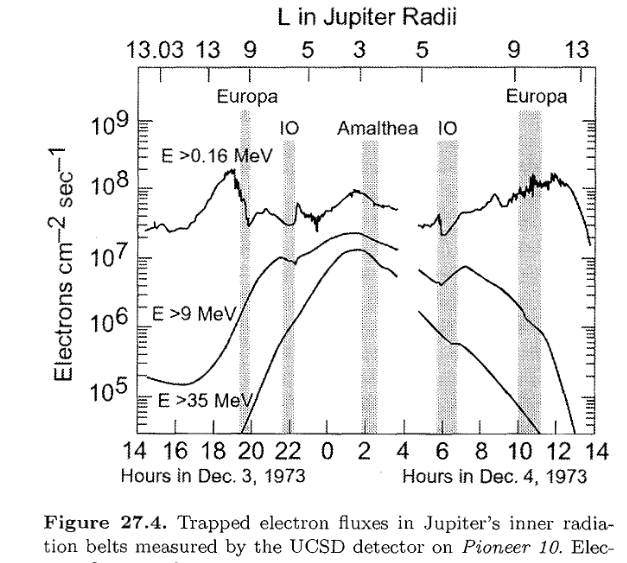
Figure 27.4, taken from
Bolton et al., Chapter 27 in "Jupiter: The planet, satellites, and
magnetosphere", Cambridge University Press, 2004.
How bad would be it for an unshielded human to visit the region around Jupiter? Perhaps you've heard of the moon called Europa; it appears to have a subsurface ocean covered by an icy crust. Some science fiction writers have imagined strange creatures living beneath the ice ...
Well, the graph below shows the radiation levels at various distances below the surface of Europa.
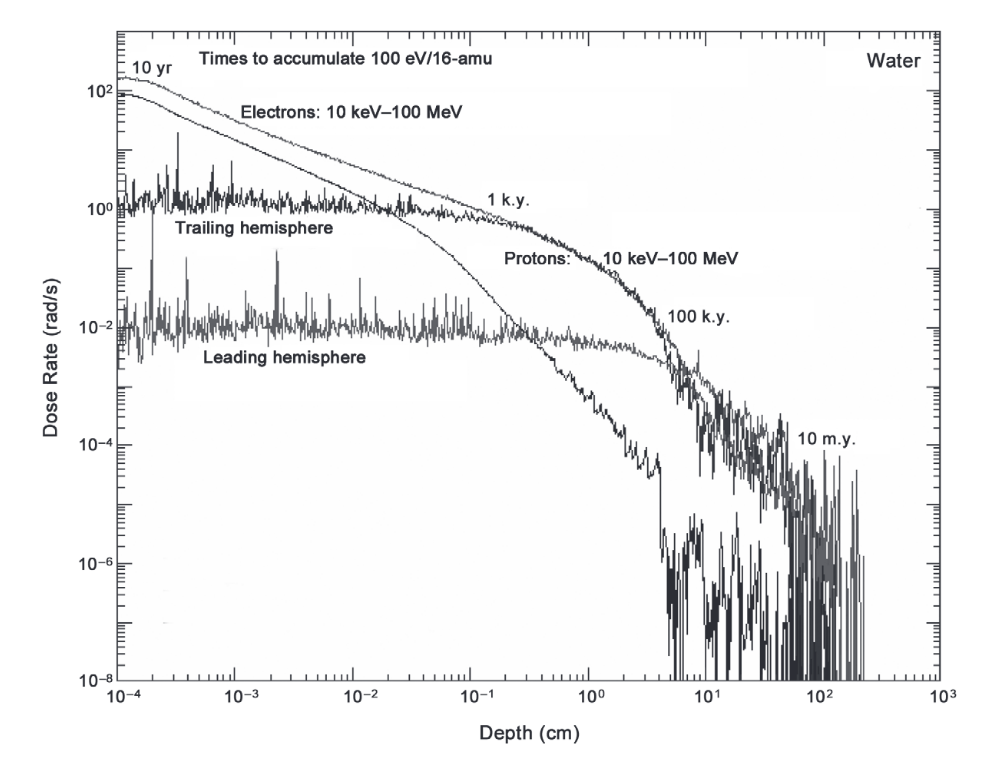
Figure 10 taken from
Paranicas et al., "Europa's Radiation Environment and Its Effects on the Surface", in "Europa", University of Arizona (2009)
Q: A dose of about 1000 rad will cause acute radiation poisoning
to a human being.
How long would an unshielded human last on Europa?
If you want to figure out how long you might live -- long enough to land the ship? Long enough to set up a shielded base? Long enough to return to Earth (ha!) -- try reading
 Copyright © Michael Richmond.
This work is licensed under a Creative Commons License.
Copyright © Michael Richmond.
This work is licensed under a Creative Commons License.